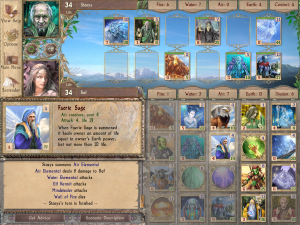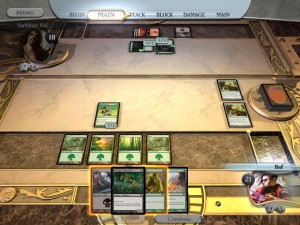Spectromancer: Ending
Spectromancer‘s single-player campaign consists of a series of maps with assorted enemies on them. At any given point, you have several available choices of who to fight next, under differing conditions and for differing rewards: some grant new spells, some extra hit points or additional starting mana, some give stranger advantages. You ultimately have to defeat everything on the map to finish it, but the ordering can make a difference to how easy this is. In other words, it’s basically the Mega Man formula, although not nearly as pronounced here as there.
The campaign is pretty short: as I’ve observed about other CCG-derived computer games, it’s probably best regarded as a tutorial for two-player dueling. It provides some nice twists on gameplay at the end, though, such as when the victory condition is to hoard mana, or when you face an opponent who can only cast fire spells but gets five fire mana per turn instead of only one, or when you suddenly have to play a couple of matches as a Spectromancer. Being a Spectromancer means you don’t have the normal fire/water/earth/air elemental spells at all, but instead get five specializations: death, holy, mechanical, illusion, and control.
Illusion had been my own character’s normal specialization, and seemed to be the only one I could choose on my first play-through (probably because I hadn’t yet found the place to enter my registration key and the game was playing in demo mode). The others in that list (as well as a sixth, Chaos) were things I had encountered in enemies — Control seemed a particularly fearful thing to me, because its focus is on depowering the opponent and preventing you from doing stuff. But these are not the only specializations in the game: apparently the Steam bundle that I bought included some DLC defining a few more that I hadn’t seen at all, such as Sorcery and Demonology. Now that I’ve completed the Campaign mode once, I can start over with any of them.
But you know something? I’m probably not going to spend much time with these new options, or with the various other game modes. I’m trying out the remaining specialties in tournament mode (challenging a series of computer-controlled opponents without a plot) to see what they add, but other than that, I’m feeling like I’m pretty much done with this game. I’ve seen what it has to say.
It does have some pretty good ideas. If the campaign took me longer to complete, I could keep writing about one interesting twist per session and not run out of material for some time. I particularly liked the mechanic of the Elementals, a common highest-level summon: their attack power is equal to your mana pool in the corresponding element. This means that their strength is potentially unbounded, but only if you don’t weaken them by spending the mana. So once you have elementals in play, they distort your decisions. Also, if you summon an elemental as soon as you have enough mana, you spend all the mana in the act of summoning it and leave it with no attack strength at all — but it’s usually worth it anyway, because elementals also increase the rate of mana gain for their element.
One more thing I’d like to comment on before closing this: the plot. The campaign mode’s story is mostly forgettable, just your basic dark lord destined to rise again and chosen one seeking out the scattered fragments of an artifact in order to battle the encroaching darkness. But at the end, it manages a twist on the idea that I don’t recall seeing before [SPOILERS]: it ultimately turns out that, in the previous age, after the Sauron wannabe lost his bid for world domination, he repented and started to seek redemption. The player character has forgotten that he is none other than the same dark lord, risen again for the purpose of stopping what he put in motion a thousand years previously. I think the last game that I saw do something this clever with a Chosen One plot was The Longest Journey, which went in a rather different direction. Why are we not seeing more variations like this? Would they grow tiresome if we did?
 Comments(0)
Comments(0)
